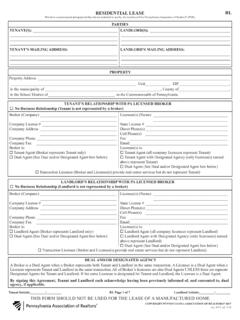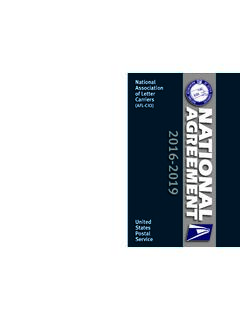Transcription of Mortgage Acts and Practices – Advertising Rules (MAP)
1 Mortgage Acts and Practices Advertising Rules (MAP). The Federal Trade Commission (FTC) has implemented the Mortgage Acts and Practices Advertising (MAP). Rules , effective as of August 19, 2011. The MAP Rules are designed to prohibit misrepresentations regarding Mortgage products. Along with forbidding misrepresentations by a broad group of entities, including real estate agents and brokers, the Rules also impose a new recordkeeping requirement that could affect the daily business Practices of many Realtors . Q: Where did this rule come from? A: Congress passed the Credit Card Accountability Responsibility and Disclosure Act or Credit CARD Act -- in 2009. Though the bulk of this law applied to protecting consumers from various issues related to consumer credit cards, it also authorized the FTC to make Rules related to unfair or deceptive Practices regarding Mortgage loans, loan modifications or foreclosure rescue services.
2 Loan modification and foreclosure services were handled in the MARS regulations ; these regulations deal with Mortgage loans. Q: Does the FTC really regulate these things anymore? Isn't there some new agency for that? A: Much of the FTC's former responsibility in this area has transferred to the Consumer Financial Protection Bureau (CFPB) as of July, 2011, but the Rules had already been drafted before this change took effect. Moving forward, the CFPB will have responsibility for these Rules , but because the Rules are very similar to existing FTC regulations regarding general misrepresentations in Advertising , the FTC will still have enforcement authority. Q: Aren't there already other Rules about Mortgage loans?
3 Why do we need these? A: There are many existing laws, regulations , Rules and policies regarding the truthfulness and accuracy of Mortgage loan information. Many of those other Rules are often very specific (for example, Rules specifying how a loan APR must be calculated and disclosed) or very broad (general bans on misleading Advertising ). The MAP Rules do not supersede any existing Rules , but are meant to work in tandem with those Rules to implement the obligations placed on the FTC. Q: What do the Rules regulate? A: The MAP Rules make it a violation for any person to make any material misrepresentation, expressly or by implication, in any commercial communication, regarding any terms of any Mortgage credit product.
4 It also imposes a requirement that those who make commercial communications keep copies of the communications and certain other information for two years after the communication is made. See the questions below for definitions of each underlined term. Q: Who is covered? Does it only apply to lenders or Mortgage brokers? A: The Rules prohibit misrepresentations by any person. A person is defined as both individuals and corporate entities, so a real estate brokerage and Mortgage brokers are subject to potential liability just as are individual agents or loan officers. Also, the commentary to the rule states that the FTC intends the term any person to apply as broadly as possible to any individual or entity that supplies information regarding a Mortgage product including real estate agents or even Advertising agencies that pass along information that turns out to be misleading.
5 MAP Rules - Page 1 of 4. ver. 08/23/2011. Q: Are there any exclusions from the Rules ? A: The Rules can only apply to entities over which the FTC has jurisdiction. This means that most banks and Federally-chartered credit unions are not covered by the Rules though Mortgage brokers and state-chartered credit unions are. But the exclusion for certain lenders does not carry through to other entities distributing commercial communications with their information. For example, if an exempt bank makes a misrepresentation, the FTC cannot prosecute. But if a real estate salesperson makes a misrepresentation based on information provided by the bank, the salesperson is not automatically exempt from prosecution.
6 Q: What counts as a material misrepresentation? . A: Section of the rule contains a list of over 20 specific misrepresentations that are prohibited, including items such as the rate or amount of interest, the variability of interest rates, payment amounts and the terms under which a consumer can purchase any additional products such as credit insurance. The list is not exhaustive misrepresentations not in the list are also prohibited but this provides a good idea of what is being targeted. Q: How bad does it have to be in order to be a material misrepresentation? Does the whole communication have to be false? What if there's something wrong in one paragraph, but it's fixed somewhere else in a document?
7 A: The Rules are very broad in prohibiting any material misrepresentation. In the commentary, the FTC notes that a misrepresentation can be express or implied, and that if there are multiple ways to interpret a communication it is a possible violation if even one of those ways appears to be misleading. It also goes on to note that it applies to documents in multiple languages, so if a document contains misleading statements in a Spanish-language explanation, but the information is correct in English, it is still a potential violation. Q: What is a Mortgage credit product? . A: The definition of this term has two parts. First, it is any form of credit that is secured by real property or a dwelling.
8 A dwelling includes any building with 1-4 residential units, and includes condominiums, cooperatives and manufactured homes (mobile homes). Second, the secured credit must be offered or extended to a consumer primarily for personal, family or household purposes.. To be covered, a loan must meet both criteria. For example, a business loan secured by a personal residence wouldn't be covered, nor would a personal loan secured by a warehouse or a 20-unit apartment building. Q: What sorts of communications are covered? A: The rule only applies to potential misrepresentations in a commercial communication, defined as a written or oral statement that is designed to effect a sale or create interest in purchasing goods or services.
9 Basically, it is meant to cover a communication in which the consumer receives specific information about a particular loan product, where the intent is to move the consumer closer to make a purchasing decision. For example, a brochure that explains the Mortgage process would not be a commercial communication because the purpose of the brochure is to educate consumers about the process, not to get them to actually buy a product. Similarly, making statements like rates are near an all-time low would probably not be covered because it is a general statement about the market. Providing a buyer with a lender's rate sheet listing the current rates for specific loan products would be covered as a commercial communication, however, since the intent of that information is to assist the consumer in making a decision on what loan to apply for.
10 It is also likely that the rule covers a statement like I can't believe the FHA 30-year loan is at since that is a statement with detailed information about a specific Mortgage product. MAP Rules - Page 2 of 4. ver. 08/23/2011. Q: Do these statements have to be in particular format ( , written, spoken, etc.) to be covered? A: No; there are virtually no limitations on what constitutes a communication. The rule lists over 30. examples of types of communications, including letters and mailers, telemarketing or on-hold scripts, training materials provided to marketing partners, TV or radio ads, and website content, but also makes clear that a communication in any other medium is also included.




